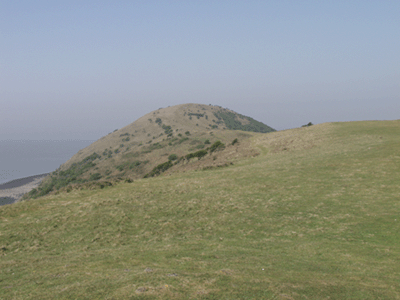
|
| The Brean Down promontory, looking east from the temple site towards the Bristol Channel. (photo: John Pearce) |
The temple at Brean Down lies at the eastern, landward, end of a mile long promontory projecting westwards into the Bristol Channel. The Down is a continuation of the Mendip Hills, divided from them by the river Axe, the mouth of which lies immediately to the east. To the south are the flat lands of the Somerset levels, to the north Weston Bay.
The temple itself lies on the eastern summit of the Down, immediately adjacent to a prehistoric barrow. This close association between a Roman temple and a prehistoric monument is not uncommon in Britain. The site enjoys wide views north and south over the Bristol Channel and eastwards over the Somerset levels, although the view west is obscured by the Down's western summit. When freshly plastered and painted the temple could have been identified from some distance away against the background of cliff, green downland and sky.
In the absence of modern flood defences and drainage, the ancient landscape would have looked very different. The high land of the Down would have been an island in the Roman period, as it had been earlier in prehistory, surrounded by brackish saltmarsh. However drainage in the Roman period of the Somerset levels for agriculture meant that the promontory would perhaps have been less remote than before. The temple lay on the margin of an intensively exploited Roman landscape, documented in the many villas south and south-west of Bristol and around Bath, stretching from Bath to the coast. On the Mendips to the east lead was mined throughout the Roman period; extraction was centred on the town at Charterhouse.
The temple would have served as a landmark for sea traffic in the Bristol Channel, although the period of the its construction and use may have been a turbulent one in the history of the Bristol Channel when this coastline perhaps became increasingly vulnerable to sea raids from Ireland. These dangers are probably responsible, for example, for the building of the fourth century fort at Cardiff, one of several new or refurbished military installations on Britain's western coast.
previous: introduction next: history and buildings